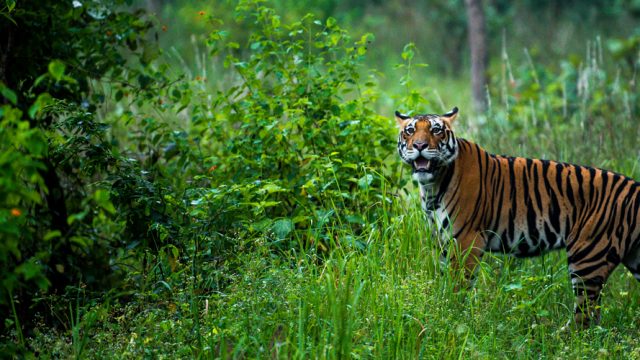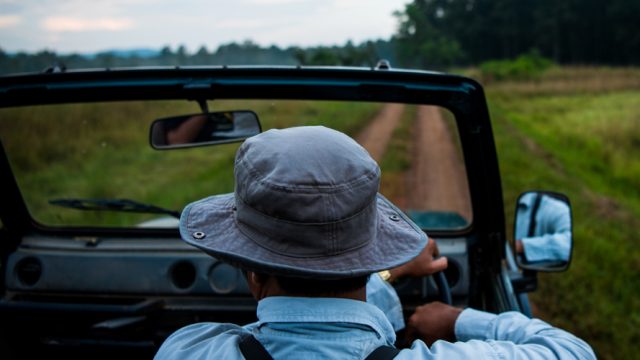Sprawling antlers rise out of the tall wild grass in Kanha National Park. The bush conceals the animal they belong to. “Barasingha,” whispers Pranad Patil, naturalist at Singinawa Jungle Lodge. Slowly, the tawny-hued deer reveals itself, its regal frame golden in the afternoon sun. More members of the herd emerge from the grass. The handsome young males are distinctive with the 12 points of their antlers, a unique characteristic that lends the deer its name. Kanha in Madhya Pradesh is the only habitat of the rare hard-ground swamp deer, a species that was brought back from the edge of extinction. Mere minutes after we drive through the park’s Mukki Gate, I’m lucky enough to spot the unsung star of this forest.

For most visitors to Kanha National Park, a healthy population of the big cat is a major lure. But it is the region’s revival of the barasingha that is among India’s biggest conservation success stories. The previous evening, chatting with the passionate naturalists sitting in Singinawa’s cosy lounge, I had heard the inspiring tale.

Once abundant across north and Central India, the barasingha or swamp deer are now only found in Uttar Pradesh, Assam, and Madhya Pradesh. The hard-ground barasingha, a sub-species endemic to Central India, numbered at around 3,000 in the late 1930s. Hunting, poaching, and encroachment on their habitat led to a rapid decline in their numbers. In the 1970s, their population fell into the double digits, with fewer than 70 individuals left in the world. The barasingha prefer a particular kind of native grass, and it was the destruction of this habitat that was among the key causes of their decline.

Conservationists focused on first restoring native grasslands, removing weeds and invasive species like the lantana. In 1973, Project Tiger was introduced. The conservation programme was aimed at protecting the striped cat, but its ethos lay in a holistic protection of the environment. This approach contributed significantly to bringing back the barasingha’s preferred habitat. As villages were shifted out of the park, native grasslands reclaimed the area. The barasingha returned; today a healthy population of around 700-800 inhabit Kanha’s meadows.
Thrilled at my encounter with the rare species, I turn my attention to the forest, fresh from monsoon showers. The ubiquitous sal rises straight and solemn towards the sky. Jamun, the revered mahua, and the crocodile-bark tree, add to the dense canopy, full of active langurs and 300 species of birds.

Among India’s largest tiger reserves at 2,051 sq km, Kanha stretches across the Maikal range of the Satpura Hills. Every few yards, as the landscape transforms almost suddenly, the forest takes on entirely different avatars. One moment, the trees close in on us in the most sinister fashion. The next, expansive meadows blend into the purple horizon. These diverse habitats are home to sloth bears, jackals, dhole, wild boar, and leopards.

As we drive on, Pranad and Rakesh Solanki, naturalists from Singinawa, easily pick out perfectly camouflaged birds on bare branches, and in thickets far away. While I try and spot them through binoculars, they open a well-thumbed copy of Wildlife of Central India: Photographic field guide, by David Raju (who also happens to be a naturalist at the lodge) and Surya Ramachandran. This exercise helps me commit these names and images to memory. Weeks later, I think back to the racket-tailed drongo, orioles, the yellow-and brown rufous treepie, and the tiny scarlet minivet I spotted that afternoon.
We spot a herd of chital feeding on the undergrowth. A little way off, a stately sambar chomps on leaves. I muse that it’s unusual to see two species in such close proximity. Pranad explains that while chital are grazers, sambar are “browsers”, meaning they eat low-hanging leaves. The two species don’t compete for the same food, and therefore coexist harmoniously.

The park has just about reopened after the monsoon, and the jungle is a dense tangle of foliage and colour. Thimble-sized red munias fly out of the tall grass. Wild purple flowers dot the meadows. Branches extend onto the narrow trails, and often, we have to duck to avoid them. But this also means that the forest’s smallest creatures are more accessible to us. On the under side of a leaf, Pranad points to a tiny whitish lump. To my untrained eye it looks exactly like a bird dropping. It turns out to be a bird dropping spider, a master of disguise, effectively avoiding predators.
Often, we stop to listen to the sounds of the forest, straining for a sign of the apex predator, but all is silent. The whirr of our jeep scares a group of mud-puddling common crow butterflies. I’m fascinated to see a swarm of butterflies rise in unison from a patch of wet earth. Nectar lacks certain salts and minerals. Butterflies absorb these minerals from mud where animals may have watered the soil, enriching it with nutrients.

While driving in through the Mukki Gate, I had crossed the swollen, boulder-strewn Banjar River. The big cat often pads along its muddy banks, stopping for a drink.
On the return, I catch a glimpse of the Bamni Dadar plateau rising within the park, purple in the fading sun. This is the highest point of the park at 870 metres, but it is closed to tourists. In the soft light, Kanha’s landscape is truly stunning. Sunlight filters through the leaves, the streams are clear as crystal, and still waterbodies reflect the sky.
We pull up along an elevated trail with watering holes on both sides. Manmade waterbodies in meadows like these are former village sites, now relocated out of the park.
The pond to our left thrives with activity. Barasingha have their noses in the water. “Eating the moss,” the naturalist says. Further away, a herd of gaur sits on the banks. The massive Indian bison can weigh up to 1,000 kilos. Spotted deer quench their thirst, as langurs frolic in the trees above them.

To my right, the still surface of the pond is a mirror to the sky, white clouds lazily drifting across a sapphire expanse. A cormorant sits on a solitary branch poking out of the water. It feels like I’ve stumbled into an oil painting. Just one of many such glorious scenes on the drives through Kanha.
THE INFORMATION
Getting there: The closest airports to Kanha are at Jabalpur (180 km/4 hrs) and Nagpur (260 km/5.5 hrs). The closest railhead is at Gondia Junction (120km/3 hours).
Singinawa Jungle Lodge
Address: Mukki Gate, Kanha National Park
Website: www.singinawajunglelodge.com
Tel: 0124 4908610
Tariff: Doubles from ₹20,000 per night inclusive of all meals and taxes. Safaris cost ₹5,500 per jeep, which accommodate six.
Safaris
Although most visitors choose to book safaris through their lodge it is possible to book independently.
Open: Oct 1 – Jun 30
Hours: The park administration runs twice daily open-top jeep safaris from 6 a.m. to 11a.m. and 3 p.m. to 6 p.m.; park is closed on Wednesday afternoon.
Booking: Book permits online at forest.mponline.gov.in/.
Entry: Permits per jeep cost ₹1,550 for the core zones (Kanha, Kisli, Mukki, Sarhi)
and ₹1,250 for the buffer zones. Each jeep seats six. Vehicle and guide charges are extra and payable at the gate, shared by all occupants of the jeep. Carry government-approved photo ID.
Tip: For the best safari experience with the best trained naturalists, book through your lodge (₹5,500 per jeep via Singinawa).
MPonmymind
Madhya Pradesh
Madhya Pradesh Tourism


